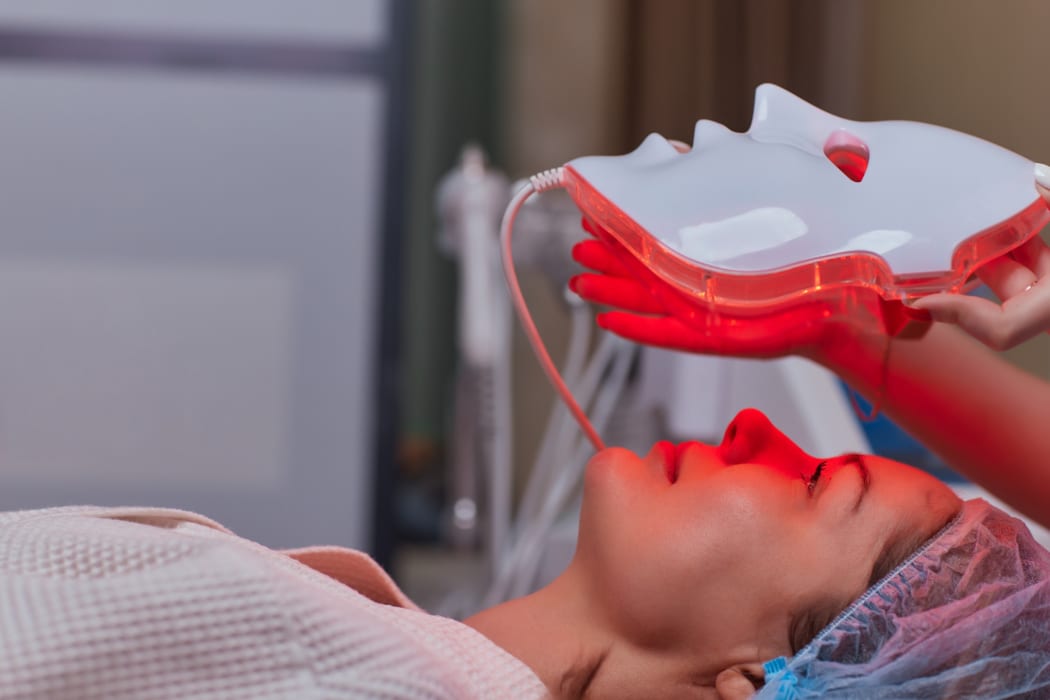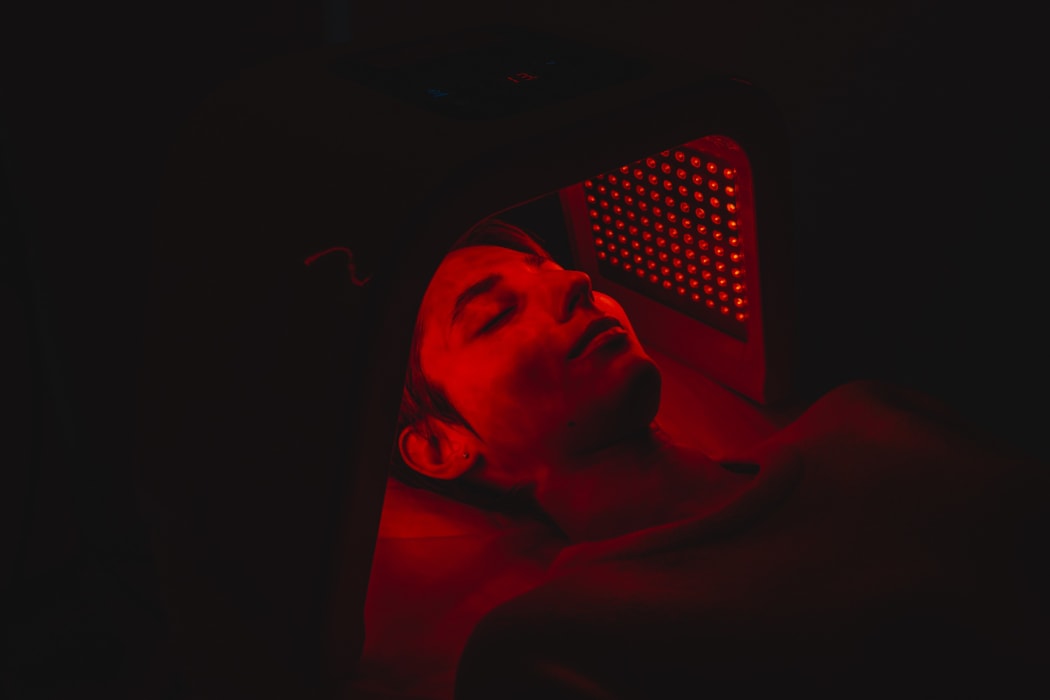
Photo: 123RF
Healthy or Hoax host Stacey Morrison puts the spotlight on the latest in anti-aging skin treatments - light therapy.
Follow Healthy or Hoax on Apple Podcasts, Spotify, iHeart or wherever you get your podcasts
The history of light therapy
Denise Ryan, vice president of global brand management for BioPhotas, (the company that manufactures the Celluma light therapy device), says light therapy was "sort of a serendipitous or a accidental discovery".
In the 1960s some scientists who were researching whether laser therapy could reduce cancer tumours in rats found an odd side effect. While it turned out the light was at too low a level to impact the cancer, the rats wounds healed faster than expected and their hair grew faster and shinier.
"They knew they had discovered something and that something turned out to be low level light therapy or as we call it today, photobiomodulation," says Ryan.
Then in the 1980s NASA began experimenting with low light for stimulating cell activity in plants and when they found it helped the plants to grow, they thought they would see what it did to human tissue.

Photo: 123RF
What is it actually doing to us?
What low-level light therapy does to human cells is is similar to photosynthesis, Ryan says.
"When you send specific wavelengths of light into human tissues at very specific, low doses, within a certain range, human cells are capable of absorbing the light and converting that energy into cellular energy."
That energy helps compromised or damaged cells get back on track and when used in, for example, fibroblast cells which generate the collagen and elastin, it helps keep our skin looking plump, she says.
"The NASA research showed us that it helps tissue to heal and repair at about 3 to 6 times the normal rate.
"And that's for the average person. And the healthier you are to begin with, the faster you might see results. But honestly, everybody gets to see your results provided the device they're using has been designed to follow the known scientific parameters for effectiveness."
What are the parameters?
Light wavelengths are actually measured in nanometers and Ryan says it is a very narrow segment of the electromagnetic spectrum that has the ability, when delivered in the correct doses, to be absorbed by human tissue and used to generate this extra energy.
That range is roughly between 400 and 1000 nanometers and includes the colours blue, red and near-infrared.
And to be therapeutic, that low-level light needs to be emitted at a rate of between two to 10 joules per centimetre squared.

Picturesque view of green meadow and beautiful rainbow in cloudy sky Photo: Olga Yastremska, New Africa, Afr
What are the risks of light therapy?
Ryan says there aren't really any risks, although there are people who should avoid it, such as if you have a history of seizures or epilepsy.
"It's very stimulating regardless of where you place it on the body," she says.
She also recommends avoiding light therapy if you are taking any light sensitive medication or injectable steroids and light therapy over a pregnant belly or lactating breasts because there have been no studies to prove the therapy's safety in those cases.
Not all devices are equal
There is a huge range of at-home light therapy devices available online. But Ryan says BioPhotas researchers have looked very closely at other products on the market.
"We haven't yet found one that actually emits within the known range for effectiveness," she says, "So I'm not saying they won't do anything, but they won't do the same thing as a device that's working and emitting energy within this specific range."
What about other colours in the spectrum?
Not every wavelength is capable of being absorbed by the cells to have a therapeutic result, says Ryan.
"Like yellow and green and even amber. I've seen pink, I've seen purple. These are not scientifically proven wavelengths. So when you're looking for an effect of light therapy device run a mile when you see anything with yellow, pink or purple."
A half hour light therapy treatment in a clinic costs roughly a $100, but you will be advised to get more than one for the best results.
You can get a take-home Celluma device in New Zealand for $1700.
The treatment
Stacey was given a Celluma light treatment at The Beauty Assembly, the New Zealand distributer of the product. She describes the feeling of being under the lights as like being in the movie Ant Man when he travels to another universe and the lights themselves gave her a "zinging" feeling.
After half an hour under the lights, Stacey thought she could see a very slight change to some of her fine lines, but the best thing was there was no redness so she was able to go about her day as usual.
Chantel Priddy, the clinician, says the light therapy would have stimulated the cells deep down in the skin and the effect would last for a few days as those lower level cells grew out.
"So that's another thing I love about the light is that it keeps working," she says, "And you can't overdo it. Your cells will absorb as much as they will and then that'll be it. It's like vitamins, you kind of get rid of what you don't need."
The science
There are studies on LED light therapy going back to 1987 showing positive outcomes for saggy skin and wrinkles. A 2005 study, showed 90 percent of the 300 patients who received LED light therapy observed a softening of skin and reduction of fine lines.
But Dr Harriet Kennedy a dermatologist and associate editor of the Australasian Journal of Dermatology, says there is a bit of a disconnect between what happens in real life and what happens in the lab.
She says in studies that have looked at real life outcomes, there is some evidence of reduction in inflammatory acne lesions, but only a handful of studies that show any benefit for rejuvenation or wrinkles.

Dermatologist Dr Harriet Kennedy Photo: Harriet Kennedy
"The other thing which is a complicating factor is a lot of the studies actually use a different light source than what's used in some clinics and particularly used in home based light treatments," she says.
In the studies, the source of light is either a laser or IPL (intense pulsed light) with a filter while in a lot of clinics and particularly in the home light devices, the light source is LED (light emitting diode).
"The difference is that the light waves are less organised in an LED light source," says Kennedy, "Whereas in laser the light waves are all sort of in parallel to each other or traveling in the same direction at the same time. And so it's not known whether you can expect the same results from an LED light source as you can from a laser light source with a filter."
Some studies show that the positive effects are there no matter what the light source is, she says.
"It's not so much that it's less likely to work, it's just that it's less backed by science."
Kennedy also warns that although LED light sources are supposed to be safe for our eyes, there has been a case reported of toxicity to the retina.
"I would recommend anyone using these devices his eye protection," she says.
So is light therapy worth the time and effort?
Kennedy also warns that while the studies did show benefits, they also used regimes where the light therapy was given about twice a week for a minimum of a month, if not longer and the benefits were not seen for up to six months later.
But she says the studies found that people felt good.
"So the studies showed improved quality of life and improved overall well-being," she says, "Whether that was a result of being enrolled in a study or whether that was the machine or not, it's hard to say, but that's something not to be overlooked."
She says as long as you are protecting your eyes, light therapy sits slightly on the healthy side but don't expect it to make you look younger overnight.
"It's important to kind of understand what you're paying for and not to be swept up in the marketing and the hype. I think the risks are minimal as long as it's affordable."

